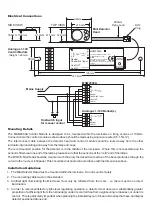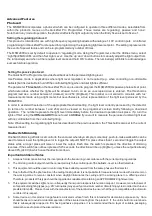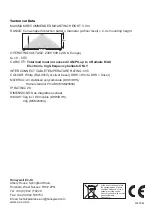
Advanced Features
Photocell
The MSM2000A incorporates a photocell which can be configured to operate in three different modes, selectable from
within the product’s menus on the QuickSet Pro Programmer. These modes are ‘regulating’, passive’ and ‘none’.
Note that in
any
mode of operation, the photocell affects the light output only when the Entry Scene is set to Scene 1.
Setting the regulating photocell
This product is intended for use with high frequency regulating ballasts with analogue 1-10V control inputs. An infrared
programming tool QuickSet Pro is required for programming the regulating light level set point. The setting is preserved in
the event of a power failure and can be re-programmed any number of times.
The MSM2000A is set by default to operate in ‘regulating’ mode. Using the Programmer, enter the Utilities menu, select
‘LightSpot/MLS/LCM’ and then ‘Set Light Level’. Use the ‘up’ and ‘down’ buttons to manually adjust the light output from
the luminaire(s) and when at the required level press and hold ‘OK’ to store. The luminaire(s) will blink to acknowledge a
successful store operation.
Setting the passive photocell
The QuickSet Pro Programmer provides feedback as to the perceived lighting level.
Use Passive mode in applications where light level regulation is not required (e.g. when controlling non-dimmable
ballasts) but it is desirable to hold off the controlled lighting when natural light is sufficient.
The parameter
‘Threshold’
on the QuickSet Pro menu is used to program the MSM2000A’s passive photocell set point,
which determines whether the lights will be allowed to turn on as an unoccupied area is entered. The threshold is
programmed as a number between 1 (darkest) and 254 (brightest). This number is not scaled to correlate with ‘lux’
measurements made using a light meter, but nevertheless is a true representation of the light level perceived by the
MSM2000A.
In order to assist with selection of the appropriate threshold setting, the light level currently perceived by the detector
(in terms of a number between 1 and 254) can be viewed on the progammer’s screen briefly following a download
operation. The number represents the light level immediately before the download operation took place.
Tip: turn the
lights off first using the
IR Remote/HC5
menu found in
Utilities
if you want to measure the perceived ambient light level
with no contribution from the controlled lighting.
Note: When setting the regulating light level as described in the previous section, the Threshold is also set to the current
measured level.
OneSwitch Dimming
OneSwitch dimming affords local control to the end-user whereby a simple, momentary, push-to-make wallswitch can be
used to raise or lower the lighting level or to toggle the output ON/OFF. A press of less than 1 second will toggle the output
status while a longer press will raise or lower the output. Each time the switch is pressed, the direction of dimming
reverses. If the switch has not been pressed for 5 seconds, the direction will be up (brighter) - unless the output is already
above 90% (dc 8V) in which case the direction is down.
Important Additional Notes
1.
A means for disconnection must be incorporated in the fixed wiring in accordance with the current wiring regulations.
2.
The dimming control output should be connected only to the control input of the ballasts - never to other detectors.
3.
This equipment should be used to control only those ballasts powered from the same phase as the detector.
4.
Due to the fact that the photocell is on the ceiling looking down, it is not possible for measurements made with a lux meter on
the working plane to remain constant when daylight illuminates the ceiling and the working plane to a differing extent.
Therefore, products of this type should be regarded as capable of maintaining an APPROXIMATE light level only.
5.
This equipment switches lights no more frequently than would a responsible human occupant. However, manufacturers of
some particular lighting types (e.g. ‘2D’ luminaires) may specify a maximum number of switching cycles in order to achieve a
predicted lamp life. Please check with the manufacturer of the luminaires to ensure that they are compatible with automatic
controls in this respect.
6.
Some devices in this product range feature a silvered surface finish; this is intended for decorative purposes only. Care
should be taken to avoid accidental separation of the silvered coating from the product. If the unit is built into a luminaire
that is subsequently wrapped in film having adhesive properties, it is recommended that a layer of suitable packaging
material be used to protect the silvered area.






















